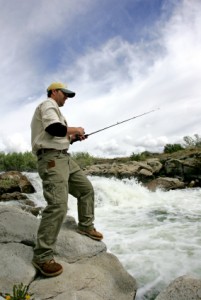Walleye Fishing
The walleye is a freshwater fish, found in rivers, lakes, and tributaries. It is a good sized  fish, reaching 30 in and 15 lb on average, although this will vary by location. Walleye tend to grow larger further south where the water is warmer. There are usually regulations regarding how many walleye may be taken at a time, so be sure to check your local laws. Walleye can be a challenge, but they are among the the best freshwater fish for eating.
fish, reaching 30 in and 15 lb on average, although this will vary by location. Walleye tend to grow larger further south where the water is warmer. There are usually regulations regarding how many walleye may be taken at a time, so be sure to check your local laws. Walleye can be a challenge, but they are among the the best freshwater fish for eating.
The best time of year for walleye is late winter and early spring. This is pre-spawn time for walleye, and many of these fish will migrate miles during the season. You will have the most luck in major tributaries near dams or rapids. Walleye tend to gather in large numbers in these areas, since there is more aerated water for spawning. Shallow water is also usually more populated during this time of year. The walleye you find in the shallows will be smaller, but smaller fish are better for eating if that is your goal. Like many fish, walleye are most active around dawn and dusk and tend to feed during this period. Walleye often travel in schools, so you will have the best luck if you find a school that is already feeding.
There are several kinds of bait that can be used to attract walleye. Its main prey is usually the minnow, so this fish is always a good option. Walleye also respond well to leaches and night crawlers. Lures tend to perform best when they are bright colors, most notably florescent red or chartreuse, since these fish have fairly good eyesight in dark conditions. Crank bait and spinners can also be useful. If you don’t have extensive equipment, a simple live minnow is probably your best bet.
Vertical jigging is one of the best ways to attract walleye in deeper water. Once your lure is in the water, tip the rod up and down to make the bait rise and fall in the water. Make sure you don’t allow the line to become too slack, however, since a fish that bites will be more likely to get away on a slack line. In more shallow water, horizontal jigging is also useful. In this case, move your rod from side to side in an S pattern. You may want to vary the speed at which you reel in the line. Start slow, but if you aren’t having much success, experiment with different speeds. You may also want to occasionally jerk the line to mimic more realistic prey.
Trolling is also an excellent way to catch walleye. Trolling is traditionally done by dragging the line behind a boat. This method is highly successful with walleye, especially as the weather grows warmer and the fish become more active. Make sure your boat isn’t moving too quickly, however, as this will result in an unrealistic looking lure, and you will have fewer bites. There are motors designed specifically for trolling, if you find this necessary.
Walleye favor slightly different areas in the summer time. Try fishing among any kind of vegetation. If the weeds have an obvious border, you can run your lure just along the edge. Many walleye hide in these weeds in order to hunt and will strike when something passes close by. Reefs, fallen logs, inlets, and rock bars are all also good prospective fishing spots. At night, you will probably have more luck in the shallows. You may even find some large fish in these areas after the sun goes down.
Cloudy days, dark water, or choppy conditions also tend to bring out the walleye. Wind between 5 and 15 miles per hour is known as “walleye chop”. The lower light and increased aeration make the fish become much more active and apt to feed. As the silt on the bottom gets stirred up, minnow often become disoriented, making them easy prey for the walleye. Try weed beds and the shallows near the shorelines to take advantage of these conditions. Jigging will probably be your best option to attract a large number of walleye. Just be sure the place you’re fishing from is secure.
Walleye fishing can be a challenging, but very rewarding experience. With a little preparation and a few different options to try, you have all you need to make your fishing trip and extremely successful one. Keep the walleye’s natural habits in mind to provide the most tempting lures and enjoy your trip.
